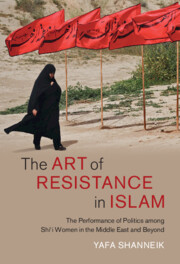 The Art of Resistance in Islam
The Art of Resistance in Islam Book contents
- The Art of Resistance in Islam
- Cambridge Middle East Studies
- The Art of Resistance in Islam
- Copyright page
- Contents
- Figures
- Preface
- Note on Transliteration
- Introduction
- 1 Trajectories of Shiʿis in the Gulf and Their Presence in Europe
- 2 The Rites of Mourning within Shiʿi Islam
- 3 Performing the Sacred
- 4 Aestheticization of Politics
- 5 Fatima’s Apparition
- 6 The Power of the Word
- 7 Conclusion
- Bibliography
- Index
- Books in the Series
2 - The Rites of Mourning within Shiʿi Islam
Published online by Cambridge University Press: 06 January 2022
- The Art of Resistance in Islam
- Cambridge Middle East Studies
- The Art of Resistance in Islam
- Copyright page
- Contents
- Figures
- Preface
- Note on Transliteration
- Introduction
- 1 Trajectories of Shiʿis in the Gulf and Their Presence in Europe
- 2 The Rites of Mourning within Shiʿi Islam
- 3 Performing the Sacred
- 4 Aestheticization of Politics
- 5 Fatima’s Apparition
- 6 The Power of the Word
- 7 Conclusion
- Bibliography
- Index
- Books in the Series
Summary
This chapter covers the historical and contemporary development of the rites of mourning within Shi‘i Islam. References from historical sources on the performance of mourning rituals since the Umayyad period lay the foundation for a critical discussion on what constitutes a ritual and when the performance of commemoration rituals started. Most women interviewed believed Zaynab, Husayn’s sister, to have initiated mourning practices for the first time in order to keep the memory of the killing of her brother alive. Others, mainly within Shi‘i scholarship, see the initiation of the practice as having been shaped later by men. This chapter serves as the foundation for the whole book as it introduces each ritual practice, understood as an act of resistance, with a particular focus on the role women play therein.
- Type
- Chapter
- Information
- The Art of Resistance in IslamThe Performance of Politics among Shi'i Women in the Middle East and Beyond, pp. 65 - 95Publisher: Cambridge University PressPrint publication year: 2022
